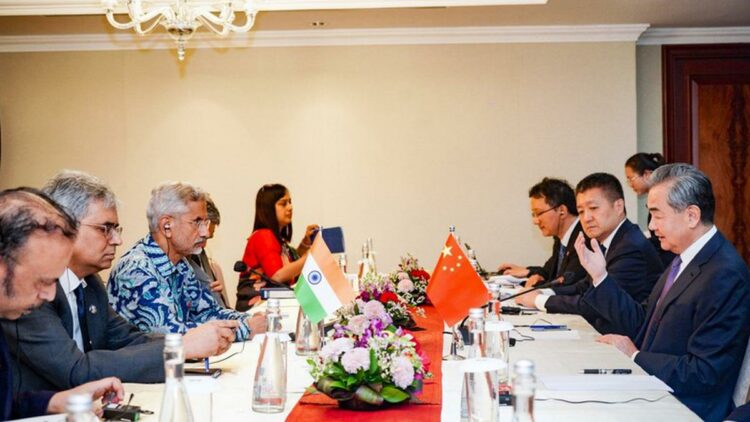On July 14, 2023, the External Affairs Minister of India, Subramanium Jaishankar, discussed outstanding issues along the Line of Actual Control (LAC) with top Chinese diplomat Wang Yi along the sidelines of the East Asia Summit in Jakarta, Indonesia.
The meeting on July 14, 2023, was Jaishankar’s third most intense engagement with the Chinese sides in recent months, following bilateral talks during the visit of Chinese Foreign Minister Qin Gang to India for the G-20 ministers meeting in March 2023 and for the Shanghai Cooperation Organisation (SCO) gathering in the Month of May 2023.
In both meetings with Qin, Jaishankar underlined the importance of peace in the LAC as a pre-requisite for normalcy in bilateral relationships and called for China to take the former disengagement of troops in the two remaining friction points.
A third meeting was expected in Jakarta, but Qing Gang did not turn up and cited that he was unwell. Instead, his predecessor Wang Yi who was promoted to the Politburo and also holds the ruling Chinese Communist Party (CCP) Central Commission for Foreign Affairs, attended the meeting at Jakarta.
“Just concluded the meeting with Wang Yi of the office of CCP Central Commission for Foreign Affairs,” Jaishankar said in a Twitter message on July 14, 2023. “Discussed outstanding issues related to peace and tranquillity in Border areas. Our conversation also covered the EAS and the ARF agenda, BRICS and Indo-Pacific.”
In the month of May 2023, Jaishankar said following its meetings with Qin Gang that both sides had a frank discussion at the border, and India made it crystal clear that relations with China were not normal and could not be normal if peace in the border areas was disturbed.
Qin Gang replied by calling both countries “to draw experience and lessons from history and steer the bilateral relations from a strategic and long-term perspective, the Chinese Foreign Ministry said then. Qin also called both sides to consolidate existing outcomes, strictly abide by the relevant agreements and protocols work to ease and cool down the situation at the border areas.”
However, Indian officials say that the Chinese Military (PLA) has continued to drag its feet in the slow-moving negotiations to restore peace and complete disengagement in all seven friction areas that have seen tensions following multiple PLA border transgressions in April and May 2020.
Both India and China have disengaged in five areas and created buffer zones in some of them, even as the tens of thousands of troops still remain deployed in forward areas close to the LAC.
In June 2023, India and China held yet another round of diplomatic talks on the impasse along the LAC in the Ladakh Sector. The remaining friction points along the LAC include Depsang and Demchok. China and India share a disputed border in the Himalayan region. The border disputes include the state of Arunachal Pradesh (south Tibet from a Chinese angle) and the Aksai Chin area.
Since the border is not clearly demarcated, there have been cases where periodic tensions, border incidents and military standoffs occur. China also has border skirmishes with Bhutan, mostly over the Doklam Plateau. China claims it as a part of its territories, and Bhutan asserts sovereignty over it.
The Doklam Standoff, in 2017, between Indian and Chinese troops, was also involved in the disputed area as it is located at the tri-junction of India, China and Bhutan.
Apart from the land-based disputes, China also has maritime disputes in the South China Sea with countries like Vietnam and Malaysia. It also claims Taiwan to be a part of its territory and wishes to reunify it with the mainland. However, Taiwan operates as a separate political entity with its own government, military and constitution. China is at loggerheads with the Philippines over the Scarborough Shoal and the Spratly Islands.

















Comments